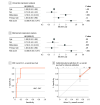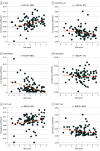Exploration of Immune-Related Gene Expression in Osteosarcoma and Association With Outcomes
- PMID: 34342651
- PMCID: PMC8335580
- DOI: 10.1001/jamanetworkopen.2021.19132
Exploration of Immune-Related Gene Expression in Osteosarcoma and Association With Outcomes
Abstract
Importance: Host immune dysregulation is associated with initiation and development of osteosarcoma. In addition, immunotherapy for osteosarcomas requires some knowledge of the immune state of patients.
Objective: To perform an immunogenomic landscape analysis based on The Cancer Genome Atlas (TCGA) project, which provides osteosarcoma samples with clinical information.
Design, setting, and participants: This genetic association study was conducted from July 20, 2020, to September 20, 2020, as a secondary analysis of public data. Cox regression and risk score analyses were used to construct signatures of immune-related genes (IRGs) in 84 patients with osteosarcoma from TCGA with corresponding clinical information. Patients were divided into high- and low-risk groups with 42 individuals in each group according to their risk scores. Data were analyzed from July 20 to September 20, 2020.
Main outcomes and measures: Differentially expressed genes (DEGs) were analyzed between groups, and potential molecular mechanisms, expression regulation, and immune cell infiltration were also explored using bioinformation methods. A prognostic model based on independent risk factors selected from multivariate Cox hazard ratio regression was established to estimate 1-year overall survival.
Results: In this genetic association study based on 84 samples from patients with osteosarcoma from TCGA (mean [SD] age, 15.0 [4.8] years; 47 [56.0%] men; mean [SD] follow-up time, 4.1 [2.8] years), a total of 14 survival-associated IRGs were identified. Patients assigned to the high-risk group had worse survival than patients from the low-risk group (1 death [2.4%] vs 26 deaths [61.9%%]; P < .001). The protein digestion and absorption pathway was one of the associated pathways in the functional enrichment analysis (gene ratio, 2:8; P < .001). The prognostic model based on metastases at diagnosis and risk score performed well in 1-year overall survival estimations (area under the curve, 0.947; 95% CI, 0.832-0.972). The risk score was correlated with immune cell infiltration (B cells: r = 0.331; P = .002; macrophages: r = 0.410; P < .001; CD8 T cells: r = 0.230; P = .04).
Conclusions and relevance: This genetic association study developed a prognostic modeling tool for osteosarcoma based on IRG expression profiles, which could result in improved survival rates through more individualized therapies. Further research on IRG expression profiles could provide potential targets for future studies on immune treatment for osteosarcoma.
Conflict of interest statement
Figures




References
-
- Bielack SS, Kempf-Bielack B, Delling G, et al. . Prognostic factors in high-grade osteosarcoma of the extremities or trunk: an analysis of 1,702 patients treated on neoadjuvant cooperative osteosarcoma study group protocols. J Clin Oncol. 2002;20(3):776-790. doi:10.1200/JCO.2002.20.3.776 - DOI - PubMed
Publication types
MeSH terms
Substances
LinkOut - more resources
Full Text Sources
Medical
Research Materials

